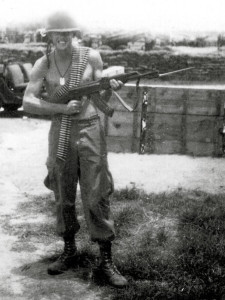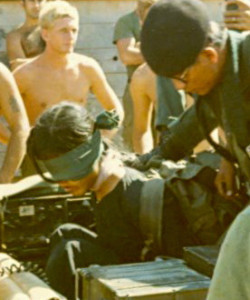Captain Hank Parker – Battery Commander – Part Five
Captain Hank Parker
PART FIVE
After being wounded at Betty I go back to Sherry to recuperate and I’m an immediate celebrity. I’m wounded, I got war stories, and I got trophies: my captured AK-47 rifle and North Vietnamese Army web gear. The AK-47 makes its way around the battery because I also have several banana clips of ammo and everybody wants to shoot it. They want to hear and feel the difference from an M-16.

Parker With His Captured AK-47
At Sherry I walk the guns and visit the guard towers and have the same kinds of conversations I had with Captain Wrazen. You get close. Relationships you never forget. On this trip I’m telling the guys, “You have bailed us out more than once. You’re appreciated.” They like to hear that.
Rik Groves (Crew Chief on Gun 2) in one of his journal entries talks about the frustration of not knowing the consequences of their artillery fire. When I’m out as a Forward Observer I call back to the Fire Direction Center after every mission and give the body count, the weapons count, and any blood trails we saw. I let them know that they had bailed us out, saved our asses. It is important to me to let the gunners know that their fire was accurate, it was timely. I puff up my chest with the 3/506 Infantry and brag about Sherry, “My guys can knock the nuts off a gnat.” And they can! You know I am not going to call in first round high explosive if my guys are not expert artilleryman.
At the same time I tell the Sherry guys we’re in a dangerous area here. I’d seen the extensive bunker and tunnel complexes just north of Sherry. I’d fought through them so I know the North Vietnamese and Viet Cong are camped on our doorstep. To make matters worse this is Ho Chi Minh country. When I was in Hawaii before Vietnam I went to the library and read as much as I could about Vietnam. Phan Thiet came up in my reading because Ho Chi Minh was a school teacher in Phan Thiet. I try to impress on the guys that this is hometown for Ho Chi Minh. These people revere him and are loyal to him. We have to keep that in perspective all the time. Anything that comes into the battery or goes on around the battery you might as well consider to be unfriendly.
The Poor Elephant
After a couple days of recuperation I’m out with Delta company of the 3/506 again and a new company commander, Captain Roy Kimoto. This is a large operation with the entire battalion, all three line companies, in tandem with Regional and Popular Forces. There are close to 1500 soldiers on the ground.
We are the last unit to combat assault into the mountainous region north of Sherry. The fighting is heavy, at a higher level even than the action at Betty just a week earlier. With artillery support from Sherry we kill and wound a lot of enemy soldiers, and we destroy a large number of base camps and bunker complexes. We are extremely effective and put a big dent in the North Vietnamese regulars and the Viet Cong in the entire Binh Tuan Province (where Phan Thiet is located).
Captain Kimoto is a competent infantry commander, but once I get real annoyed him. He has me out bushwhacking, well out of the range of our 105s. I do not like that; I want to be within range of Sherry.
But I am still within the maximum range of the 175s at Sandy (Firebase northeast of Sherry. The 175 mm howitzers there were the largest land artillery pieces in Vietnam, with a maximum range of 25 miles. They had a considerable range error, meaning they shot both long and short of the target, and making it imperative to be well away from the target and certainly off the target line.) I fire the 175 once at night. We are ON THE TARGET LINE – not safe! – not safe! – and we kill an elephant. The elephant cries all night before dying. Oh my God it’s horrible. That shakes me to the core it is so sad. I get mad at Capt. Kimoto and say, “You can’t get us outside of our support range of my 105s.”
In the meantime I get on various radio frequencies and manage to get in touch with some U.S. Air Force. These are guys running missions up north and on their way back. I say, “Have you got any ordnance?” They tell me what they have and I give them coordinates and they fire it for me. So at least the enemy thinks we have air support, which I figure scares them off.
POW
We are now further south, and close into Sherry. Regional and Popular Forces encounter a company size unit of Viet Cong well dug in. We send a recon element in support, together route them, and capture four prisoners. One of the prisoners is a high value POW. From documents he is carrying and what our interpreters get from him, he was on the attacks at Sherry and Betty. We bring him back to Sherry for an initial interrogation, where there is a picture of him in a jeep. The others go to Betty, and he also eventually goes to Betty for full interrogation.

POW Blindfolded
The result of the interrogation is that our artillery had really hurt their main North Vietnamese force. He acknowledges to the interrogators the damage we did to them at Sara, Sherry and Betty, all within a period of just six weeks and due largely to the artillery. Sherry is an ongoing thorn in their side that they want to remove.
From that time LZ Sherry becomes an even higher priority objective for the enemy.
Sherry is a forward-placed artillery unit right smack dap in the middle of their infiltration route. They have to come by us. Add to that the radar installation that goes in at Sherry, which is anti-personnel and allows us to see movement around the area. This does two things. It makes us more dangerous to them, but the radar tower also gives them a nice tall aiming post. You’d think we’d be easy to take out, but they find out very quickly that we’re not, that we pack a punch.
I’ve got a lot of pride in the artillerymen at Sherry because, try as they may and try as they might, the enemy does not get us. They do their damage, but they never get our battery. All the way up to Field Force and Corps levels people come down to see what is different about LZ Sherry. They want to be able to say, I was at Sherry. Even General Corcoran comes to LZ Sherry.
Lieutenant General Charles Corcoran commanded the First Field Force, comprising all military units and operations for approximately half of South Vietnam. He later played a role in getting Andy Kach his Bronze Star. He passed away the next year on September 24, 2013 at the age of 99.
Combat R&R
(Rest & Recreation)
I was only out with Kimoto a few weeks when I get notice I am going on R&R. Alex Taubinger, another lieutenant out of B Battery at LZ Sherry, comes to the 3/506 Infantry to replace me. They send a helicopter out to get me, but the terrain is too dense for the chopper to get in. I have the guys blow some trees down for me with det cord (flexible plastic tube filled with explosive) so I can get to the helicopter. Climbing up one of the trees we had blown in half I gash my leg pretty bad. So I end up going on R&R with a wound I gave myself.
I go to Hawaii and stay at Ft. DeRussy on Waikiki Beach, where I had been stationed with Captain Schlottman before going to Vietnam. I’m driving through the Marine base, and as I pass the ammo bunkers there I see attack planes coming over the mountains and dive-bombing. I scramble out of the jeep as fast as my leg will let me and take cover. I’m thinking, This isn’t how Rest & Recreation is supposed to work. I learn later, to the delight of my companions, that it was a scene being shot for the movie Tora! Tora! Tora!



